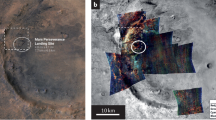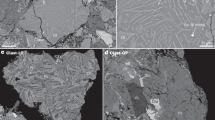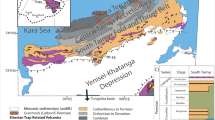Abstract
AT least 15 separate localities for sapphirine-bearing rocks have been found in the Arunta Block, a Precambrian metamorphic complex in central Australia (Fig. 1), although only two have been documented in any detail1–3. Such rocks are the most spectacular examples of a suite of rocks with a distinctive, characteristic chemistry. This suite includes, inter alia, the better known cordierite–anthophyllite rocks, and is widely distributed both within the Arunta Block and world-wide. From field observations it is proposed here that two different geological processes, one sedimentary or diagenetic and the other volcanic, generated rocks that are now indistinguishable in their whole-rock chemistry and mineral assemblages. It had formerly been proposed that sapphirine-bearing rocks of volcanogenic and sedimentary origins were mineralogically and chemically distinct4.
This is a preview of subscription content, access via your institution
Access options
Subscribe to this journal
Receive 51 print issues and online access
$199.00 per year
only $3.90 per issue
Buy this article
- Purchase on Springer Link
- Instant access to full article PDF
Prices may be subject to local taxes which are calculated during checkout
Similar content being viewed by others
References
Woodford, P. J. & Wilson, A. F. Miner. Mag. 40, 589–594 (1976).
Hudson, D. R. & Wilson, A. F. Geol. Mag. 103, 293–298 (1966).
Woodford, P. J. & Wilson, A. F. Neues Jb. Miner. Mh. 1, 15–35 (1976).
Lacroix, A. Bull Soc. franc. Miner. 52, 76–84 (1929).
Vallance, T. C. J. Petrol. 8, 84–96 (1976).
de Rosen-Spence, A. Can. J. Earth Sci. 6, 1339–1344 (1969).
Chinner, G. A. & Fox, J. S. Geol. Mag. 111, 397–408 (1974).
Warren, R. G. in 1st Aust. geol. Convention, Proterozoic Geol., Geol. Soc. Aust. Abstr. (1975).
Schulz, O. & Vavtar, F. in Time and Strata-bound Ore Deposits, 260–270 (Springer, Berlin, 1977).
Stoessell, R. K. & Hay, R. L. Contr. Miner. Petrol. 65, 255–267 (1978).
Lacroix, A. Ann. geol. Serv. Mines Madagascar, Fasc. 11 (1941).
Schreyer, W. Tectonophysics 43, 127–144 (1977).
Shaw, R. D., Stewart, A. J. & Warren, R. C. in Bur. Miner. Resour. Aust. Rep. 208, 117–127 (1978).
Whitmore, D. R. E. in Geol. Surv. Can. Pap. 68, 37–54 (1969).
Stewart, A. J. & Warren, R. G. BMR J. Aust. Geol. Geophys. 2, 21–34 (1977).
Wilson, A. F. Geol. Soc. Aust. Spec. Publ. 3, 401–412 (1971).
Peterson, M. D., Lambert, T. B. & Ayres, D. E. CSIRO Miner. Res. Lab. Tech. Commun. 63 (1977).
Wilson, A. F. Miner. Mag. 42, 89–92 (1978).
Author information
Authors and Affiliations
Rights and permissions
About this article
Cite this article
WARREN, R. Sapphirine-bearing rocks with sedimentary and volcanogenic protoliths from the Arunta Block. Nature 278, 159–161 (1979). https://doi.org/10.1038/278159a0
Received:
Accepted:
Published:
Issue Date:
DOI: https://doi.org/10.1038/278159a0
This article is cited by
-
U–Cr-rich high Mg-Al granulites from Karimnagar Granulite Belt, India: implications for Neoarchean-Paleoproterozoic events in southern India
Mineralogy and Petrology (2013)
-
U–Pb zircon and monazite age constraints on granulite-facies metamorphism and deformation in the Strangways Metamorphic Complex (central Australia)
Contributions to Mineralogy and Petrology (2003)
-
Sapphirine-kornerupine rocks from the Reynolds Range, central Australia: constraints on the uplift history of a Proterozoic low pressure terrain
Contributions to Mineralogy and Petrology (1994)
-
Metamorphic and tectonic evolution of granulites, Arunta Block, central Australia
Nature (1983)
Comments
By submitting a comment you agree to abide by our Terms and Community Guidelines. If you find something abusive or that does not comply with our terms or guidelines please flag it as inappropriate.



